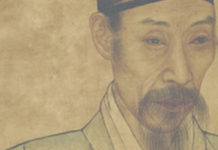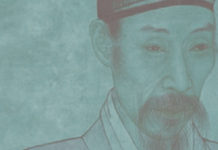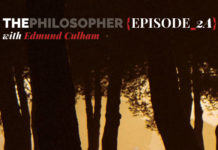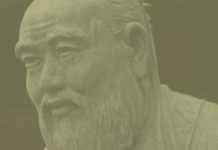After a period of unpopularity, a resurgence of Confucian thought began in the late Tang dynasty. Later, scholars such as Zhu Xi and Wang Yangming, determined to reintroduce or rediscover the true value of Confucian teachings in the Song and Ming dynasties, with their revisions being termed (though this is a Western application) Neo-Confucianism.
Therein, returning to the true “source” of Confucianist texts was necessary to seeking the Dao, which was seen as having been infiltrated with Buddhist and Daoist thought. Common to Neo-Confucian theories is the idea that all individuals have an innate ethical knowledge, but dispute arose from how this self-knowledge was best accessed and developed.
A rustling in the bushes over by the lake, two figures approach walking some distance apart up the path to the pavilion. Kongzi doesn’t rise but meets each with a knowing nod, suggestive of old friends. They take their seats at opposite ends of the low table.
Now, three great philosophers slide slender fingers down lengths of their wispy beards, while you try your best to look scholarly. Zhu (1130-1200) rises and exclaims, “The path to true knowledge is all around us”, explaining that what we must do is identify the “principle” (li) in things external to us.
He fixes your teacup with an indomitable stare, his eyes cold. Pausing dramatically, or perhaps because he has lost his train of thought, he then in an instant darts to his left, a long arm flailing and plucks a cockroach from the table leg. The poor critter struggles in vain as Zhu holds it between finger and thumb.
With his free hand he takes a pebble from his gown, dropping it with a “plink” on the cold stone floor. “All things around us have ‘qi’ (vital force)”, then holding the cockroach over the table, “See how it struggles to break free, this affects me more than the pebble there, it has the greater qi”.
Speaking to the room, Zhu puts forth, “We (humans) of course have the most qi of all, but this can be dangerous”. From looking around the room you would struggle to justify Zhu’s claim, throughout Kongzi watches on unmoved, while to your left Wang seems to have fallen asleep.
Although not one of the initial revisionists, Zhu’s condensing of the “Five Classics” into a canon of four works became the primary source of Confucian rejuvenation, such that it was taken as the basis for civil service exams in China.
Zhu’s philosophy rested on the idea that everything in existence could be divided into two groups, known as li and qi.
Here li, translatable as “principle” refers to the structure of the universe, such that everything in existence is embodied by li.
Qi, Zhu thought of as the “vital force” held by objects or things in reality. Although a cockroach and a pebble have different proportions of qi, both are embodied by li. Here a rationalist tendency is evident in Zhu’s thought, in that qi was considered a potentially disruptive force. For Zhu,most people were born with turbulent qi, which makes ethical action unclear. Conversely, li was thought to be a force for good. Necessary to reach a state of self-control so as to act correctly, was a realisation and knowledge of the “principle” of things in the world.














